
A Day in the Life of Missionaries in Baltimore
[mashshare]
You’ve seen them before: young men in white shirts and ties, young women in modest skirts and colorful blouses.
Always two-by-two they ride bikes, walk the streets and take public transit. All wear an iconic black tag on their shirt or suit pocket bearing both their name and the name of the Church they represent.
They are full-time, volunteer missionaries from The Church of Jesus Christ of Latter-day Saints, sometimes known as “Mormons”, and their numbers have risen in Baltimore, Maryland and around the world.
Historically, the “Maryland Baltimore Mission,” one of 405 missions in the world, has hosted an average of 120 missionaries. Longstanding Church policy required young men, called Elders, to be at least 19 and young women, or Sisters, to be 21 years of age before they’re eligible for service. But a change in policy in October 2012 reduced the age for Elders from 19 to 18, and for Sisters from 21 to 19. The effect was a surge of missionaries entering service.
 Prior to the change, the Church had approximately 55,000 missionaries worldwide. Today there are 83,000 missionaries and in Baltimore, the number has increased from 114 to 260.
Prior to the change, the Church had approximately 55,000 missionaries worldwide. Today there are 83,000 missionaries and in Baltimore, the number has increased from 114 to 260.
As in all missions, the decision to serve is voluntary and missionaries pay their own way, but the location of their service is not by choice. Church leaders at worldwide headquarters in Salt Lake City individually assign every Elder and Sister to a mission, including those who will be required to learn a foreign language. Elders serve for two years and sisters for eighteen months.
 I recently arranged to spend a day trailing two missionaries in the Baltimore Mission: Elder Anthony Burrup of Pocatello, Idaho and Elder Logan Herzog of Austin, Texas. Despite no experience with the language, both were given Spanish-speaking assignments and spent nearly two months in intense language learning at the Church’s Missionary Training Center in Provo, Utah.
I recently arranged to spend a day trailing two missionaries in the Baltimore Mission: Elder Anthony Burrup of Pocatello, Idaho and Elder Logan Herzog of Austin, Texas. Despite no experience with the language, both were given Spanish-speaking assignments and spent nearly two months in intense language learning at the Church’s Missionary Training Center in Provo, Utah.
The experience was one of the most educational and spiritually satisfying since I wore my own nametag 20 years ago on the streets of Belo Horizonte, Brazil.
When I arrived at the missionary’s apartment just outside Baltimore at 10 a.m., Burrup and Herzog had been awake since 6:30. Their morning routine, and that of every missionary, includes exercise, personal study, companionship study, teaching practice and for missionaries speaking in other languages, time to improve their language skills.
After they finishing quizzing one another on weather-related Spanish vocabulary, they prayed at the door — in fluent Spanish — and began their day.
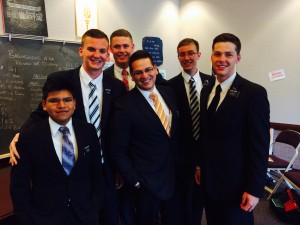 Our first stop was a planning or “district” meeting with other missionaries serving in and around the city. We rode light rail and then the metro to one of the LDS Church’s chapels downtown. En route, the elders engaged with everyone they could. One man, Ken, shared his experience living years ago in Salt Lake City and meeting with sister missionaries. Burrup and Herzog asked for and were given his email address to schedule a follow-up visit.
Our first stop was a planning or “district” meeting with other missionaries serving in and around the city. We rode light rail and then the metro to one of the LDS Church’s chapels downtown. En route, the elders engaged with everyone they could. One man, Ken, shared his experience living years ago in Salt Lake City and meeting with sister missionaries. Burrup and Herzog asked for and were given his email address to schedule a follow-up visit.
The short meeting covered teaching tips and was heavy on role playing, or as the mission calls it, “real playing.” I noted that despite most of the missionaries being native English speakers, it was entirely in Spanish.
Across the hall, another district meeting was underway with a group that covers another part of the city and meets and teaches in English. In all, there were more than 20 missionaries in the building coordinating their activities, including two senior couples.
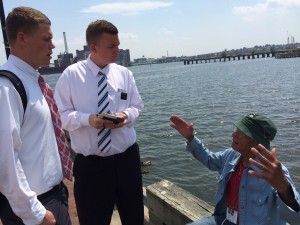 After lunch, we walked around Baltimore’s famed Inner Harbor and I watched the elders engage with anyone willing to stop and listen. Linwood, an elderly man fishing on the pier, politely declined an invitation for a visit, but spoke of his love of the Bible and for those who preach. A Hispanic man, Roberto, was thrilled the elders stopped to talk to him. He revealed that he’d once attended a Mormon congregation in another city. Now living in Baltimore, the man had been telling his daughters they needed to find a church and before their discussion ended, Roberto had scheduled a visit with the elders.
After lunch, we walked around Baltimore’s famed Inner Harbor and I watched the elders engage with anyone willing to stop and listen. Linwood, an elderly man fishing on the pier, politely declined an invitation for a visit, but spoke of his love of the Bible and for those who preach. A Hispanic man, Roberto, was thrilled the elders stopped to talk to him. He revealed that he’d once attended a Mormon congregation in another city. Now living in Baltimore, the man had been telling his daughters they needed to find a church and before their discussion ended, Roberto had scheduled a visit with the elders.
“That’s a miracle!” Burrup said as we walked away.
Herzog agreed. “That doesn’t happen often, not like that. We were led to him today.”
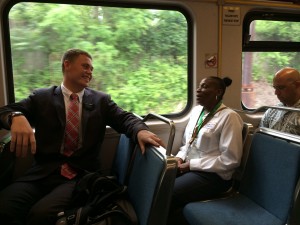 Soon we were back on the metro, then light rail, and the elders spoke to another dozen people and handed out “pass-along cards” as they walked and talked. Some were more receptive than others, but not a single encounter could be labeled rude or combative.
Soon we were back on the metro, then light rail, and the elders spoke to another dozen people and handed out “pass-along cards” as they walked and talked. Some were more receptive than others, but not a single encounter could be labeled rude or combative.
Those who expressed no interest were met with the same smile as those who did.
We returned to their apartment and climbed into their church-supplied Malibu. In nearby Lutherville, Maryland, we sat at the kitchen table of a family who recently returned to the church after years of being less active. The family credits the elders and their “church family” for their return.
 As we ate hot, delicious pupusas, the elders spoke with 16-year-old Fernando and shared ideas on how he might help a young man who’s drifted from the LDS Church. They also spoke at length of another friend who’s expressed interest in learning more. “I would love to see him baptized,” Fernando said. “I love baptisms!”
As we ate hot, delicious pupusas, the elders spoke with 16-year-old Fernando and shared ideas on how he might help a young man who’s drifted from the LDS Church. They also spoke at length of another friend who’s expressed interest in learning more. “I would love to see him baptized,” Fernando said. “I love baptisms!”
Before leaving, the elders shared tips for Fernando to continue his own preparation to serve a mission upon graduation from high school.
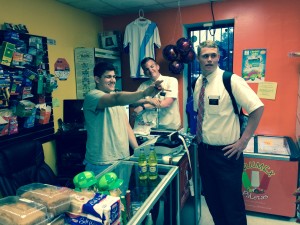 Our next stop was a Latino market to visit a man named Roy. “We go where we need to go,” the elders told me. “We don’t like to bother people at work, but he’s said it’s all right and we’ve been there before.” Between helping customers, they invited Roy to a soccer game and lobbed friendly trash-talk back and forth. Like the others, Roy was intrigued by my explanation of my experiment with the missionaries and was perfectly happy to have his picture taken and shared online. “How’s my hair?” he joked as I stepped back and took an action shot.
Our next stop was a Latino market to visit a man named Roy. “We go where we need to go,” the elders told me. “We don’t like to bother people at work, but he’s said it’s all right and we’ve been there before.” Between helping customers, they invited Roy to a soccer game and lobbed friendly trash-talk back and forth. Like the others, Roy was intrigued by my explanation of my experiment with the missionaries and was perfectly happy to have his picture taken and shared online. “How’s my hair?” he joked as I stepped back and took an action shot.
Later, we visited an investigator named Nelson in Pikesville and taught him about Joseph Smith’s First Vision. When Nelson shared that he was unsure how to pray, the elders took turns giving suggestions and invited him to pray with them on the spot. Nervous but willing, the three men knelt at wooden kitchen chairs and Nelson prayed with humbling sincerity.
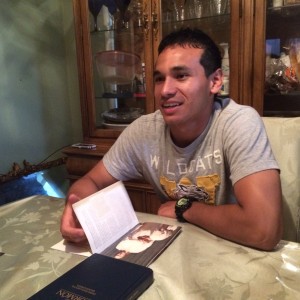 “Fantastic! Amazing! Beautiful!” the elders praised.
“Fantastic! Amazing! Beautiful!” the elders praised.
Before leaving, I thanked him for allowing me to share some of our experience online, but assured him the social media campaign did not overshadow the real reason for the visit. I offered my own testimony of the restored gospel, invited him to be baptized and promised to be there when it happened. Neither Nelson nor I needed a hashtag to tell us the Spirit was trending with us both.
Our last stop before returning to their apartment for the night was with a recent convert. While Burrup helped a child with math homework, just a few feet away Herzog chatted with the mother about weather and Mexican food. “Can we pray together?” Herzog asked as we prepared to leave.
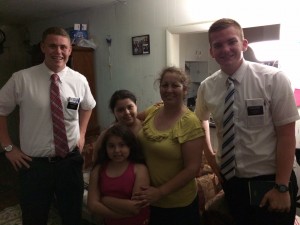 A few moments later on the sidewalk I noticed the elders practically bouncing with excitement. I asked, “Did I miss something?”
A few moments later on the sidewalk I noticed the elders practically bouncing with excitement. I asked, “Did I miss something?”
“She’s never wanted to say a prayer before!” Herzog said. “Did you catch that, Elder Burrup?” They discussed the development for much of the drive home.
At 9:30 p.m., we walked back into their living room. “Right on time,” Herzog said. “We have to be home by now at the latest.” Then he turned to his companion before the door was even shut. “Ready to plan for tomorrow?”
Preparing for my long drive home that night, I sat in my car and marveled at how in a single day we’d performed some service, worked with less-active members, engaged in finding activities, met with other missionaries and coordinated with members. Sitting alone, I contemplated how their enthusiasm, their desire for obedience and their teaching skills prove the bar has truly been raised.
 I also took time to thank heaven that the Spirit had been our most important companion of the day, and I enjoyed a few sweet tears that testified our day had been filled with the kind of light that only truth brings.
I also took time to thank heaven that the Spirit had been our most important companion of the day, and I enjoyed a few sweet tears that testified our day had been filled with the kind of light that only truth brings.
In the days since my adventure with these impressive and righteous servants of the Lord, I’ve considered how much has changed since my own mission. With cellphones in every pocket and with the Internet and social media available to almost everyone, we’re blessed with so many more ways to share the gospel, to engage in service with other faiths, and to fellowship than at any point in history.
So much more, however, remains the same. The study time, the meetings, the correlation and the need for practice is universal. And, of course, the overarching goal will never change: to invite others to learn more and, eventually, to enter the waters of baptism.
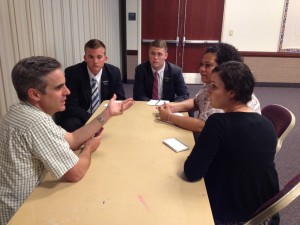 When and if you choose to spend time with the missionaries, you might find one other constant from your own mission or that of a loved one. The most important conversion for these missionaries and their 83,000 counterparts around the world probably won’t be someone they saw on a train or a pier.
When and if you choose to spend time with the missionaries, you might find one other constant from your own mission or that of a loved one. The most important conversion for these missionaries and their 83,000 counterparts around the world probably won’t be someone they saw on a train or a pier.
It’s the one in the mirror.
(Editor’s note: Jason Wright is a member of The Church of Jesus Christ of Latter-day Saints. For more information, visit churchofjesuschrist.org)

